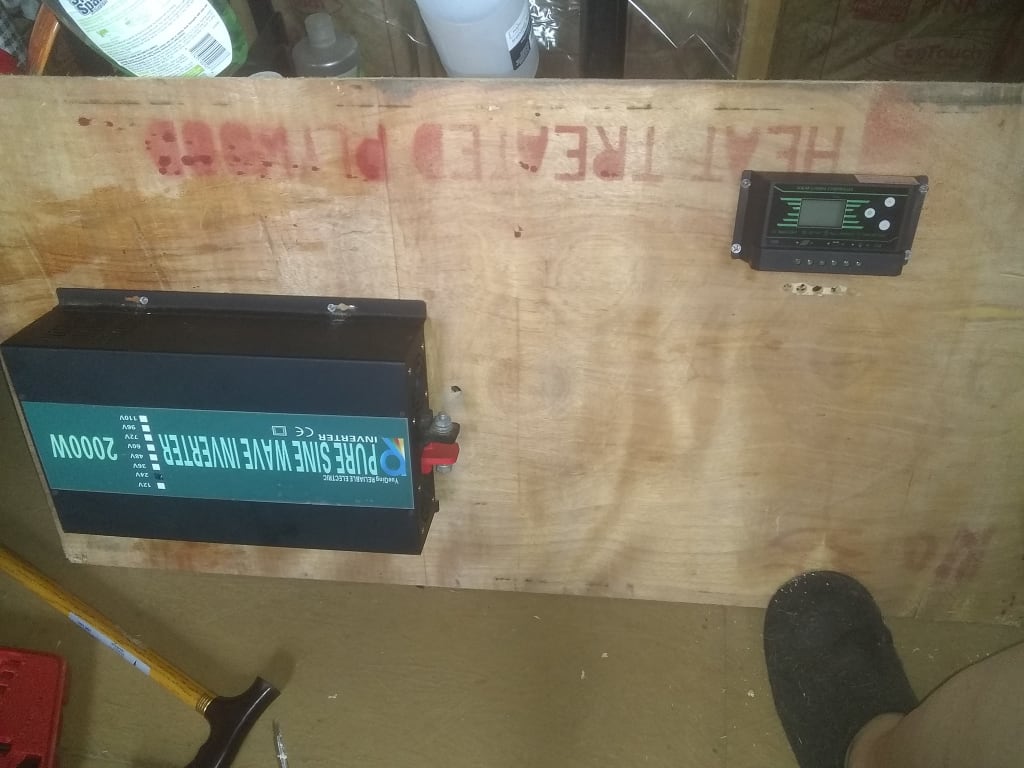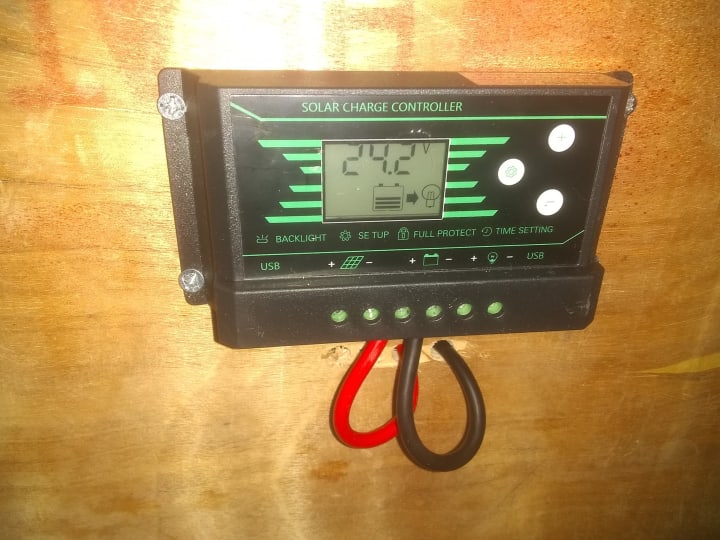Simple Solar System
Installing Batteries, Charge Controller, and Inverter

I set out to hook-up a small charge controller to my inverter, battery bank, and solar panels. My cabin is totally powered by two 100-watt solar panels except for the times I need to fire up a generator to power things when I've had too many cloudy days or need more power. I've run an air conditioner on 100-degree days by running the generator.
To be clear, I don't like running the generator. I hate the air pollution and the noise that it makes. Sometimes I just don't have a choice. I'd like to earn more money so that I can add two more solar panels and that should solve most of my power issues. Once I'm in Maine, I don't expect to need air conditioning, to be perfectly honest.
The above photo is the power controller and the inverter. The solar charge controller is absolutely necessary. It prevents your batteries from over-charging and it also prevents the inverter from running them too low. It will shut off power and everything is powered down. My inverter has an alarm that goes off when that happens and I just shut it off.
I've got a very large inverter. I admit that it is overkill, but it won't be once I have more panels and that's always been my goal. At some point in time, I'd like to have enough solar panels to power everything that I need. I think 6 panels would run everything I'd every need, once I am using a propane refrigerator.
I've had issues with my cats getting into things. My batteries are inside the cabin, which isn't ideal but because of the area that I live in, I'm afraid of theft. I plan on putting a vent in the wall because they are closed off from the inside and I have a door on the box so I can access them from inside and check them regularly.
I believe that by having them vented outside, kept cool via air conditioning and warmed via heat in winter, that they are better off than being outside where they are exposed to high temps or freezing temps, as long as they are well vented to the outside and closed off to the inside pretty well.

I have my solar panels wired in series to create one 24-volt panel, essentially. This makes the power collection more efficient. It takes less work for them to collect energy, without getting into all the technical stuff. Suffice it to say that they are able to start charging at sunrise and keep collecting power until the sun goes down.
The entire system has to match. Therefore, the batteries also have to be wired in series, the charge controller has to be able to read 24-volt power input, and the inverter has to be a 24-volt to accept a 24-volt load. The photo above shows that I have used a 'jump' cable to connect one positive terminal on the first battery to one negative terminal on the second battery.
This creates one 24-volt battery from two 12-volt batteries. I did the same with the two remaining batteries. Then the positive terminal on the first set is connected to the positive terminal of the second set, likewise with the negative, to run them together as two parallel 24-volt batteries. This is a far more efficient system that charges faster and can power more stuff at once.
When hooking up your system, you wire your batteries to your solar charge controller first. This gives it power and you'll see that it is recognizing your system as 24-volt if you have done everything correctly. The photo below shows that I've hooked the batteries up from inside the box I created, pulled the wires to the outside of the box so that I can have the controller where I can view it at any time.
The load on the controller is defaulted to 24H load but I don't have anything to connect to that so I'm not worried about it right now. In time, I will probably have lights wired to that and set them to go on at dusk and off at sunrise, for outdoor porch lights. They would connect to the two inputs on the far right. One for positive and the other for the negative connection, and signified by the light bulb icon on the screen.

Once you've got your batteries hooked up, you can hook your solar panels up and the last thing you want to do is hook-up any loads, like your inverter. My panels were already wired outside and the cables were run in through the wall. I simply had to pull the wires through my pre-drilled holes I had done and get them hooked up. These wires are bigger. They came with the panels and I think they are 8 AWG. The barely fit and were hard to bend but I managed.
The last thing to do is hook your inverter up. It hooks directly to your batteries. You don't need to have it on unless you are running anything that has to be plugged into a 110-volt outlet.
All of the power you are pulling from your solar panels is DC current, direct current. In order to power household appliances and things like laptops and chargers for other electronics, televisions, refrigerators, etc, you have to convert that DC power into AC power, or alternating current. That is what the inverter does for you.
I have a pure sine wave inverter, which refers to the wave that power forms. A pure sine wave is capable of running larger appliances without dropping off power that can cause power drops that might be bad for the appliance. If you are going to just be running a small television and charging things like cell phones, a regular inverter that isn't pure sine wave will be fine, and cheaper. I went with better.
Experience has shown me that you should get better things when you can, so you can expand your system later. This charge controller is cheaper than I wanted but I was in a pinch. I also intend to go back and add 30 amp fuses on all my positive lines coming from the batteries, solar panels and to the inverter from batteries. It is safer for all the electronics. I just didn't have the cash this week to buy them. You should install them.
If you enjoyed this little 'how to' today, don't forget that you can send me a cash 'tip' below, to go towards the new solar panels that I need, or the fuses that I need to install, or the pets that I feed, or anything else.
I appreciate you all so much! Visit me on Patreon at https://www.patreon.com/ShambalaRockFarm and become one of my treasured fulltime sponsors.






Comments
There are no comments for this story
Be the first to respond and start the conversation.